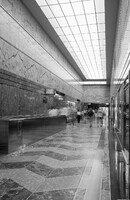Empire State Building
Shreve, Lamb & Harmon

Download1A1-SLH-ES-C2_cp.jpg (458.1Kb)
Date
1930-1931Description
General view of corridor, main level; "Standing in lonely dignity in the midriff of Manhattan, a sentinel by land, a reassuring landmark by air, the Empire State Building is the quadri-faced pharos of the city. And until outstripped by the twin towers of the World Trade Center (1975), its 102 floors were the highest in New York. Though designed at the end of the so-called Art Deco period in the 1920s, when zigzagged appliqués were prominent, its exterior shows little of the frippery characteristic of that 'decorated' period. It is, moreover, one of the very few skyscrapers with four facades, not just one facing the avenue. Zoning required several setbacks, but these were given a skillful buildup of scale at the lower levels, while the tower itself rises unflinchingly. Indented setbacks in the center of each of the long sides help lateral scale. An observation platform and a pylon topped by a television transmission antenna crown all. The architectural, commercial, and popular success of the Empire State Building depended on a highly rationalized process, and equally efficient advertising and construction campaigns. Skillful designers of Manhattan office buildings, architects Shreve, Lamb, and Harmon were familiar with the imperatives of design and construction efficiency that maximized investors' returns by filling the building with tenants as soon as possible. ... The Empire State Building, like most Art Deco skyscrapers, was modernistic, not modernist. It was deliberately less pure, more flamboyant and populist than European theory allowed. It appeared to be a sculpted or modeled mass, giving to business imagery a substantial character..." It was constructed in only 14 months. Source: Great Buildings Collection; http://www.greatbuildings.com (accessed 12/2/2007)
Type of Work
office building; skyscraperSubject
architectural exteriors, business, commerce and trade, Art Deco
Rights
Rights Statement
Licensed for educational and research use by the MIT community only